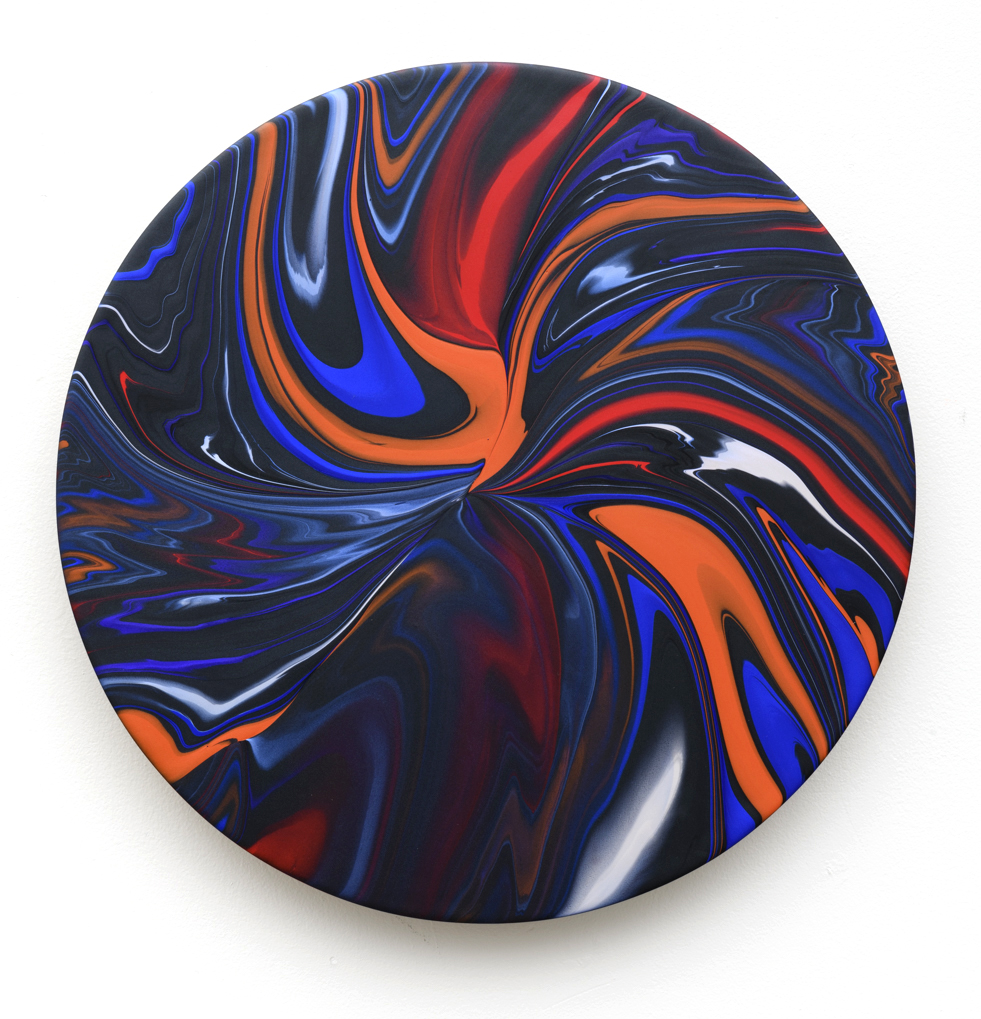
29 Dec Telluride Gallery: Hayward, Moses & Wolf in “Fluid Motion”
Fluid Motion” is first show of the winter 2020 season at the Telluride Gallery of Fine Art. A town-wide Telluride Arts’ Art Walk event is happening on January 2, 2020, 5 p.m. – 8 p.m., when the work of LA-based artists James Hayward, Andy Moses, and Jennifer Wolf will be on display.

James Hayward, courtesy Flaunt magazine.
“Good artists see better than we do,” art critic Dave Hickey.
Titled “Fluid Motion,” the first major show of the winter 2020 season at the Telluride Gallery of Fine Art features three different artists of different ages with disparate and distinct styles who peacefully, no beautifully, co-exist – but why this particular mash-up? Why did Gallery co-owner Ashley Hayward and her team choose to launch the winter season 2020 at the venue with a show of the work of her dad, James Hayward, alongside Andy Moses (son of the iconic Ed Moses, a family friend), and Jennifer Wolf?
The short answer is a nod to Pop icon Robert Rauschenberg, who once described his creative process as acting in the gap between art and life. In other words, in addition to their joint roots on the Left Coast, all three share the confidence, nimbleness, and wit that allows them to speak in many voices at once and, through their unique aesthetic languages, take the viewer on a magical mystery tour to that world between worlds Rauschenberg was alluding to. In the gap, despite distinctly different processes, color becomes the magic carpet that turns fixed facts like landscapes into open-ended themes and variations.
“With these works viewers get to explore what is dynamic and alive within us all,” said Hayward. “The finished products of all three artists contains what is best described as a pulse.”
Bottom line: James Hayward’s work, which he equates to free-form jazz, are muscular mandalas that encourage viewers to lose themselves in the swirls and twirls that shape the reflected light. Mose’s creations, largely pure color with only a hint of form running through the compositions, suggest alien landscapes that tilt psychedelic. While Wolf’s sensuous compositions are unapologetically lush and gorgeous, feminine in the very best sense of the word. In “Fluid Motion” the three artists join forces (and their distinct, but abundant talents) to “…create images that arrest our vision with their energy and urgency…,” the Gallery explains.
In other words, these three painters align by prioritizing moments and gestures over easily recognizable narratives, which take us out of our comfort zones to a place where the joy of discovery in the moment rules.
In addition to their sensuous art, their kudos alone would fill up a wall, as follows:
Hayward has had major shows at the LA County Museum of Art; the Museum of Contemporary Art, LA; the Minneapolis Institute of the Arts; and the San Francisco Museum of Modern Art. He has also received numerous major awards, including: a Guggenheim Memorial Fellowship to work in Japan, a trip that triggered the artist’s move from flat blocks of color to thickly painted (mostly) monochromes; a National Endowment for the Arts Fellowship; and a Pollack-Krasner Foundation Grant.
The Laguna Museum of Art, in Laguna, CA.; the American Jewish Museum in Bel Air CA.; the Frederick Weisman Museum in Malibu CVA; the Flow Riverside Art Museum in Riverside, CA; the Beliefs Newport Harbor Art Museum is Newport Beach CA; the Orange County Museum of Art (OCMA); and the Fondazione Michetti in Rome, Italy, have all featured the work of Andy Moses. Over his career, Moses has also had exhibits in Italy, Norway, and Switzerland.
And Jennifer Wolf, am emerging star, has been featured at the A + D Museum in LA and the Riverside Art Museum in LA. She is also a recipient of a scholarship from the Anderson Ranch in Snowmass, Colorado.
James Hayward:

Abstract #147
James Hayward is a renowned non-objective painter; which means he reshapes the natural world for expressive purposes and derives from, but does not imitate any, recognizable physical subject or impulse.
Artists, like cowboys, live an edge life somewhere between hard, isolated, isolating work, and the mythology that surrounds that whole dadgum picture. For James Hayward that goes double: he is both cowboy and artist.
Folks generally find Hayward tricked out in full regalia – hat, boots, tired jeans, a burning joint hanging from his lips. Truth is his family has been breeding Arabian horses since the early 1970s, first in Bellevue, Washington, then on a big spread in Moorpark, just north of the City of Angels. Hayward’s home on that property is modest to say the least: an aluminum trailer, plus a studio and office/storage space for work.
It all began for the celebrated artist, art historian, and teacher at age seven, when he won a Smokey the Bear drawing contest – but soon discovered he was not so good at drawing people. Since then, Hayward has won countless laurels for his hard-edged abstractions. He has had shows at major museums (see above) and galleries.
“Fluid Motion” features a selection from Hayward’s “Abstraction” series, thick paintings that initially appear to be monochromatic, but reveal themselves to be so much more upon close examination.
In Abstract #147, for example, vigorous brushstrokes in a buoyant primary blue give the monochromatic surface an energetic, even sculptural quality. Edges of strokes drift downward, but paradoxically the overall energy lifts us up.
Hayward builds up the juicy surfaces of his work with thick layers of oil paint using a grid structure, treating every mark as equally valid so that the final product appears to have no beginning and no end. Impasto became the artist’s signature in the 1980s, but despite the built-up picture plane, his images do not read as being about process alone.
They read as a magic trick only a master could pull off: the sheer weight of Hayward’s sensuous, expressive abstractions appear to defy gravity. Why don’t those roiling impasto crests collectively ooze right off the vertical picture plane like an erupting volcano? How is it those rambunctious monochromes, highly saturated wild waves of luxuriant color, don’t spill right off the canvas onto the gallery floor like an angry ocean flaunting its power?
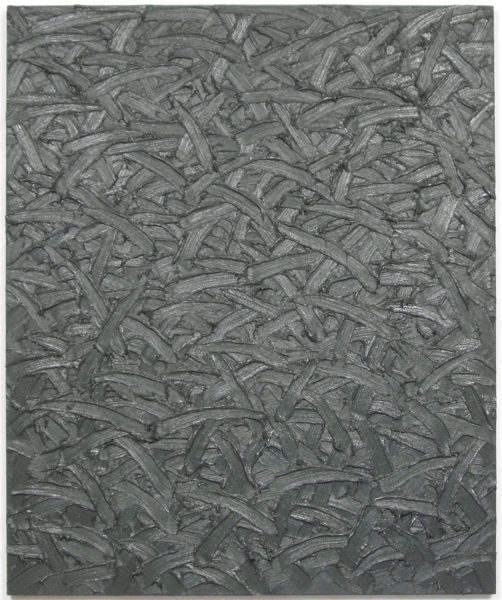
The explanation lies in dizzying sleight of hand that can only happen when the eye stops legislating and censoring and willingly yields to the hand with a brush. The hand then takes off in a fury that results in a vibrating, eye-dazzling, meditative whole.
And where is the artist in all this?
Lost in an improvisation, in that frenzied process of marking: the painting is painting the artist.
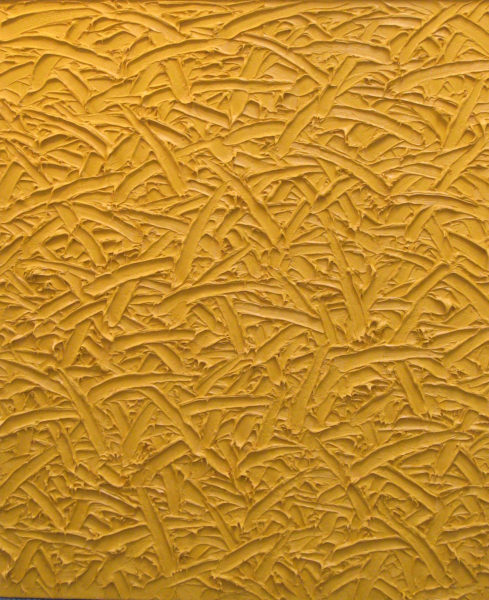
“…the heart and soul of it is the marking. In my monochromes I try to avoid there ever being a special place. There’s no chosen place. It’s totally proletariat, the marking. I want the corners to be as important as the center and I want every mark to be equal in terms of importance. Ideally, the last marks just kind of blend into the earlier marks and disappear,” Hayward told a former student in an interview in Artillary magazine.
“I would describe my dad’s paintings as visual meditations,” explains Ashley. “The mind gets lost, while the eye dances across his surfaces. It’s amazing to me how his works continue to reveal themselves to the viewer the longer he stays in place and observes. I have literally seen people transformed in amazement in front of Jimmy’s paintings. I understand that reaction. First you are struck by the beautiful, bold, heavy impasto brushstrokes, then the subtleties of the colors consume you. Finally you get lost in the rhythm of the marks, then more color variations and the play of light and shadow take hold. Truly a symphony for the eye and a delight to experience.”
A delight that is enhanced when the artist reveals another layer of motivation behind his work. In addition to identifying as a painter and teacher, Hayward wants to be known as a humanitarian, one who believes deeply in the redemptive and transformative power of visual art.
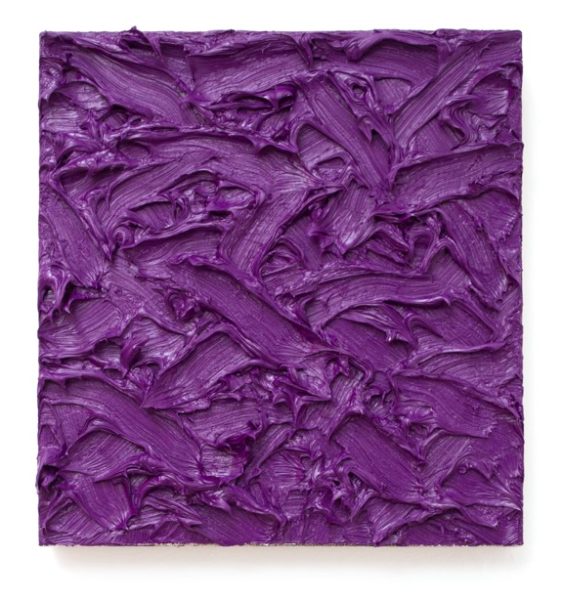
“[I want to] make something that is shareable. That your fellow human beings can maybe look at and instead of seeing war and being ashamed of our species, especially in this moment, they can look at it and go, ‘my people made that. I’m part of that…”’
It is also important to note that after decades of engagement with an artistic community, Hayward is not slowing down. The man continues to explore creative process with a sense of adventure, sometimes even painting in the dark. Reflecting on the Old Master Titian’s late work, he once commented:
“[He changed] how people think about painting, and it’s not an intellectual change or a theoretical change, it’s a change that occurred simply because an old person refused to quit.”
“Through chromatic density, shaped by the humanity of each restless mark, Hayward’s paintings open onto a world of oneness and wonder,” wrote Frances Colpitt in a book about Hayward.
Hayward is another mature painter who keeps on keepin’ on because he has more to give, more to say.
Andy Moses:
Like father, like son?
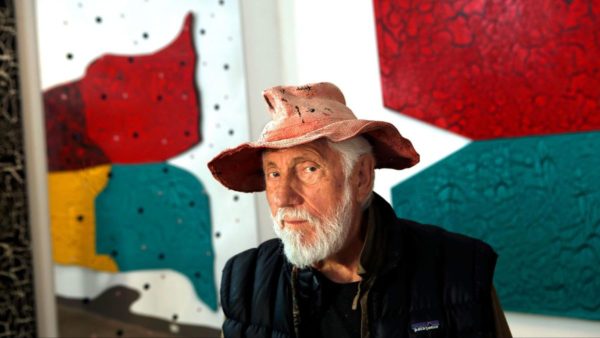
Ed Moses
Ed Moses (1926-2018), painted with an insatiable passion that spanned seven decades, from the late-1950s until just weeks before his death at the age of 91. A self-described “mutator,” Moses père mined the possibilities of abstract painting for over 60 years, leaving an indelible mark on the contemporary art world. Endlessly intrigued with the metaphysical power of his art, Moses created works about the expression of temporality, process, and presence, remarking at one point that “The point is not to be in control, but to be in tune.”
As an artist, Moses underlined the point about the visceral, instinctual nature of his work by talking about his modus operandi in terms of giving up all attempts at controlling confusion and, instead, learning to swing with it.

Andy Moses, courtesy Geomorph.
Son Andy has been described as “a quintessential Los Angeles artist.” A graduate of the California Institute of the Arts, he has been exhibiting his work for over 30 years.
Ashley Hayward first met Ed Moses – or he her – when she was a babe in diapers, a simple fact which opens the door to the history of the LA’s modern art scene in which Ashley’s father, the aforementioned James Hayward, has loomed as a large presence for most of his 70+ years.
That story also explains the subtext that underlies every one of the major shows at the Telluride Gallery since Ashley and Michael took over the venue from its original owners in January 2017: each of them has honored at least some of the major LA artists in the Haywards’ orbit – including James Hayward himself.
Moses fils has long been working in pure color, the forms in the work suggesting the nexus of abstraction and landscape. Since 2003, he has produced colorscapes in the vein of Rothko, a tip of the hat to mysterious, foreign worlds – including internal.

According to one online source, as an adolescent, Andy Moses watched Stanley Kubrick’s classic, “2001: A Space Odyssey” on the massive, curved screen at LA’s Cinerama Dome, an immersive experience that ultimately informed his concave canvases.
“I want them to refer to landscape without becoming landscape,” he once explained.
In 2017, Moses fils made the move to circular canvases and his abstract landscapes became “2001”-esque tunnels of light, simultaneously referring to planets and microscopic forms.
Andy Moses once described the patterns in his work, very deliberately chosen and composed, the “bandwidth” of a painting, a notion that does little to downplay the impression that the artist is painting something spacey and infinite, something like heat waves shooting out into the universe, expanding infinitely. Up close, Moses’ work is deliberately and manifestly otherworldly.

In his “Geodesy” series, for example, a perfectly circular form is designed with cascading interplays of color, evoking at once the Earth, fantastical worlds, and playful experiments in which color thumbs its nose at form.
“Geodesy 126” showcases intermingling forms that suggest water and continents, but with an almost fun-house-mirror quality of distortion in the mix. A faint suggestion of three-dimensionality further complicates the viewer’s experience of the abstract, which is simultaneously flat like most canvases and round like real planets.

In Andy Mose’s art we sense some of the optimism and exuberance the Sixties and Seventies returning, this Stephen King nightmare we are living in morphing back to Lucy In the Sky With Diamonds.
And that allusion to psychedelia is an echo of his illustrious dad’s “crazy wisdom,” an innocent state of awareness that is wild and free, completely awake and fresh. It is a spiritual worldview that represents thinking outside the box— moving against the stream.
Bingo.
In 2018, both Andy Moses and his dad became dual award recipients of the Artist of the Year award at Art Palm Springs.

“My painting is the encounter between the mind’s necessity for control and it’s yearning to fly…,” Andy’s dad once quipped.
Yes, like father, like son.
Jennifer Wolf:
Jennifer Wolf grew up in Southern California hiking in the foothills and swimming in the Pacific. As an undergraduate, she studied art history, an experience that deepened her understanding of the impact art has had (and continues to have) on all cultures and civilizations.

A deep interest in ancient cave paintings triggered an exploration of archaeology and, at one point in her life, Wolf was awarded a grant to spend summer doing fieldwork in Carthage, Tunisia. Discouraged by the prospect of early mornings, intense heat, and the insistent solitude nature of the work of an archaeologist, however, she determined to make art rather than unearth it. Still sensitivity to place became an important part of her creative journey.
Further, Wolf’s experience in archaeology had a major impact, inspiring her to focus on the use of natural materials including minerals, rocks, and natural dyes as the source of my pigments and color palette,“oxides and mineral deposits that run deep in the Earth’s crevices.”

It is Wolf’s color palette and her focus on fluid reactions of paint that sets her work apart from the pack and gives it a naturally distinctive feel. Unapologetically beautiful, her paintings explore the elemental nature of color and texture.
To create these soaringly gorgeous compositions, the artist controls the flow of her hand-made paints, isolating areas of lacy, textural pattern that overlap spaces of vivid color that seem to bloom and spread across a surface in energetic washes, the work then reminiscent of Sixties Color Field painters like Helen Frankenthaler.

Spanning a width of seven feet, using natural dyes, mordants, and mineral pigments, Wolf’s “Event on the Horizon,” evokes a dramatic gathering storm, light breaking through clouds, oceanic depths, or perhaps the Northern Lights. In Rincon #8, mineral pigments mixed with acrylic create an iridescent vitality in coppery hues.

Event on the Horizon
“My color palette and focus on fluid reactions of paint… sets me apart and gives my work a naturally distinct feel at a time when color just comes out of a tube.”
Summing up:
“Spending a full minute with any painting by the three artists in this exhibition — James Hayward, Andy Moses, and Jennifer Wolf — would offer at least as many sensorial thrills as a dive into a cold lake or a spin down a windy road with windows open. So much goes into preparing, composing, and building-up for each work. A brief in-person encounter has almost too much to give…,” wrote Katherine Wagley in the introduction to the show’s catalog.
“I invite you to explore the work yourself. Be curious. Stand back and observe. Walk close and notice the changes. Is there translucency, depth, and/or nuancing to the surfaces? How do you experience the color relationships? Allow the work to envelop you as your eyes glide across the surface following the push, pull, and pouring of pigment. Develop your own unique perspective and exalt in the wonder of what is sure to be an ever-changing and evolving experience with each of the artists and their work,” concludes Ashley Hayward.


Pingback:Telluride Arts: Art Walk, | Telluride Inside... and Out
Posted at 17:02h, 15 December[…] This month through early January, the Telluride Gallery of Fine Art is presenting James Hayward, Andy Moses, and Jennifer Wolf in “Fluid Motion.” These three painters align by prioritizing moments and gestures over easily recognizable narratives, which take us out of our comfort zones to a place where the joy of discovery in the moment rules.The Gallery is hosting a reception with the artists on hand, on Friday, December 27, 5 p.m. – 7 p.m. For much more on this show, go here. […]
Pingback:Telluride Arts: Art Walk, 1/2/2020 | Telluride Inside... and Out
Posted at 17:30h, 31 December[…] Through early January, the Telluride Gallery of Fine Art presents James Hayward, Andy Moses, and Jennifer Wolf in “Fluid Motion.” These three painters align by prioritizing moments and gestures over easily recognizable narratives, which take us out of our comfort zones to a place where the joy of discovery in the moment rules. For more on the artists, go here. […]